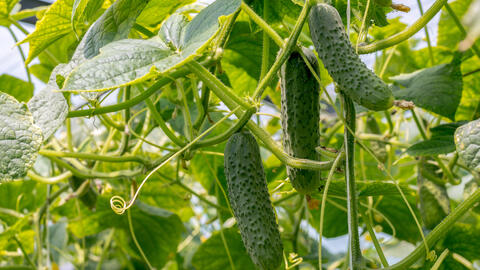The 5 Biggest Mistakes In Growing Cucumbers
For an abundant and tasty harvest of cucumbers, you must be aware of and avoid the gross mistakes you can make while growing cucumbers. So nothing stands in the way of a rich harvest.

Cucumbers produce the highest yields in the greenhouse.
Be it small, round or very large fruits: Cucumbers (Cucumis sativus) from the cucurbitaceae family are a vegetable garden classic. However, not all cucumbers are created equal. While cucumbers or snake cucumbers are usually grown in the greenhouse, peeled cucumbers (mustard pickle) and gherkins (pickles) are particularly suitable for outdoor planting.
Cucumbers need a lot of light and heat. You should therefore wait until the soil has warmed up sufficiently (at least 55.4 degrees Fahrenheit) before direct sowing the outdoor cucumbers. To be on the safe side, you should also only place young plants in the vegetable patch after mid-May. A black mulch layer works well for early sowing - it increases the soil temperature by around 39.2 degrees Fahrenheit. A fleece cover or glass container that you put over the young plants can also serve as a heat accumulator.

It is best to plant salad cucumbers in the house and then further cultivated in the warm, humid greenhouse. Even here, you should by no means start sowing too early: The seeds are only sown in pots two to three weeks before planting out. Otherwise the young plants will be too big before they come into the vegetable bed or greenhouse. The cucumber seeds germinate fastest at 77 to 82.4 degrees Fahrenheit, after germination they should be placed in a slightly cooler (66.2 to 68 degrees Fahrenheit) location. As soon as the cucumbers have developed two real leaves, they are planted out.

Be it outdoors or in a greenhouse: Cucumbers are among the strong uptakers and need a loose, humus-rich soil. They have shallow roots and must not get silted up under any circumstances. You should therefore ensure that the soil structure is good, especially in areas with heavy soils. The ideal fertilizer for cucumbers is straw-like, half-rotted horse manure, which you mix in when preparing the vegetable patch (about five liters for every 1.19 square yard). Alternatively, you can also use mature compost, which is mixed with chopped straw. A mulch layer of straw or lawn clippings between the plants also works well: It keeps the soil loose and moist throughout the entire cultivation period. Note: Cucumbers should only be grown in the same location after four years - otherwise it could lead to soil fatigue.
Those who grow cucumbers often have to deal with real or downy mildew. To avoid fungal infestations, you should pay attention to a few points when planting. On the one hand, sufficient plant spacing is important. In the greenhouse, the planting distance between the rows is 51.18 to 66.92 inches, in the row 17.71 to 21.65 inches. For free-range cucumbers, 39.37 x 15.74 inches are assumed. To avoid the plant from growing close to the ground and dry off better, climbing aids must be present. Of course, this is not an absolute must for field cucumbers and pickles, in principle all cucumbers can grow with climbing aids. In the greenhouse it is best to let the cucumber plant climb up on strings. Trellises made of wooden posts and bean trellis can be used outdoors.
In order to achieve a constant and good yield, cucumbers must be continuously supplied with water. As a rule of thumb: A plant needs twelve liters of water per kilogram of cucumber harvested. The water requirement is particularly high when the first fruits are formed. Even when it's dry, you have to use the watering can regularly: Then water daily with tempered water that is left to sit outside for some time, preferably in the morning hours. In this way you also avoid the fruits from becoming bitter. In addition, downy mildew does not get a good breeding ground if the plants get dry at night. As a preventive measure, you should only water the plants in the lower root area.
In the growth phase, cucumbers not only need plenty of water, but also adequate fertilization. Organic vegetable fertilizers are recommended, as these release their nutrients slowly and sustainably. Organic gardeners also swear by potash-rich comfrey manure or nettle manure, which is diluted 1:10 with water. For healthy growth, it is also advisable to prune the excessively dense foliage. Cutting all side shoots up to a height of about 31.49 inches after the first leaf attachment is a proven solution. The main shoots of the plants should also be shortened so that they do not become too long. The following applies to the harvest: The more often you harvest, more abundantly will the cucumber plants grow new fruits.



